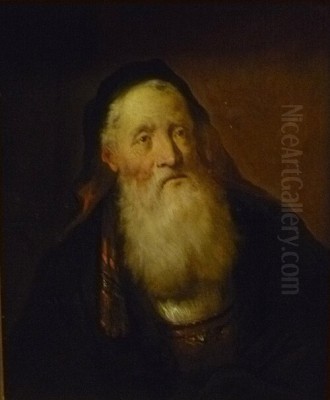
Christian Wilhelm Ernst Dietrich, often known simply as Dietricy, stands as a fascinating and somewhat enigmatic figure in the landscape of 18th-century German art. Born on October 30, 1712, in Weimar, and passing away on April 23, 1774, in Dresden, Dietrich navigated the complex artistic currents of his time with remarkable dexterity. He was a highly prolific painter and etcher, celebrated in his lifetime for his extraordinary ability to work in the manner of numerous preceding and contemporary masters, yet later sometimes criticized for the very versatility that brought him fame. His life and career, centered primarily in the vibrant artistic hub of Dresden, offer a compelling window into the tastes, patronage, and artistic practices of the German Rococo and early Neoclassical periods.
Early Life and Artistic Foundations
Dietrich's immersion in the world of art began at birth. His father, Johann Georg Dietrich, was a court painter and etcher serving the Duke of Saxe-Weimar. This familial connection provided the young Christian with his initial artistic instruction. His mother, Johanna Dorothea, hailed from the notable Thiele family and was herself connected to the court as a musician, suggesting an environment rich in cultural pursuits. Weimar, though smaller than Dresden, was a significant cultural center within the Thuringian states, providing a solid foundation for the budding artist.
Recognizing his son's talent, Johann Georg sent the thirteen-year-old Christian to Dresden in 1725 to further his studies. There, he became a pupil of the respected landscape painter Johann Alexander Thiele, who was himself known for his topographical views and atmospheric landscapes, often depicting the Saxon countryside. Thiele's guidance was crucial, particularly in honing Dietrich's skills in landscape representation, a genre that would remain important throughout his career. Dresden, the opulent capital of the Electorate of Saxony, was rapidly becoming one of Europe's premier centers for art and culture under the rule of Augustus II the Strong, offering unparalleled opportunities for a young artist.
The Court Painter of Saxony
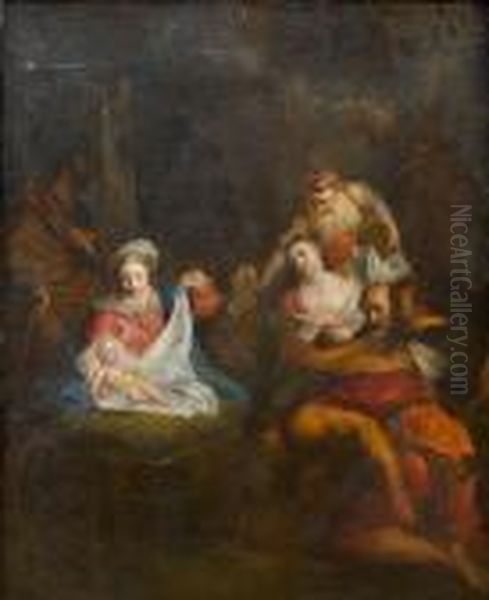
Dietrich's talent quickly gained recognition. Through the likely recommendation of his teacher Thiele, he came to the attention of the Saxon Elector, Frederick Augustus I (also known as Augustus II the Strong, King of Poland). Around 1730, at the remarkably young age of eighteen, Dietrich was appointed as a court painter. This prestigious position provided him with financial stability and access to the highest levels of Saxon society and patronage. He received commissions for decorative paintings for the Elector and his ministers, contributing to the lavish interiors of Dresden's palaces and residences.
His favor continued under Augustus II's successor, Frederick Augustus II (Augustus III of Poland), who reigned from 1733. Augustus III was an even more avid art collector and patron than his father, significantly expanding the royal collections that would form the basis of the renowned Dresden Gemäldegalerie (Art Gallery). Dietrich thrived in this environment, benefiting from the Elector's passion for art and the presence of numerous other talented artists drawn to the Saxon court. His position solidified his status within Dresden's flourishing artistic community.
Italian Sojourn and Broadened Horizons
To further refine his skills and broaden his artistic vocabulary, Dietrich undertook a crucial study trip. Sponsored by his patron, he traveled to Italy in 1734 (some sources suggest 1743, but 1734 is more commonly cited for his primary Italian journey) for approximately a year. This journey, a common practice for ambitious Northern European artists, exposed him directly to the masterpieces of the Italian Renaissance and Baroque, as well as the contemporary art scene in cities like Rome and Venice.
In Italy, Dietrich immersed himself in studying the works of Italian masters. He would have encountered the dramatic landscapes of Salvator Rosa, the classical compositions of artists from the Bolognese school, and the vibrant color and light of Venetian painters like Titian and, perhaps, contemporaries such as Giovanni Battista Tiepolo or Canaletto. This experience profoundly impacted his artistic development, adding Italianate modes – particularly dramatic landscapes and mythological themes – to his already growing repertoire of styles derived from Dutch and Flemish traditions. The trip equipped him with firsthand knowledge that enhanced the authenticity and range of his stylistic imitations.
The Chameleon of Canvas: Dietrich's Eclectic Mastery
Dietrich's most defining characteristic was his extraordinary eclecticism. He possessed an uncanny ability to absorb and replicate the styles, techniques, and subject matter of a wide array of artists from different schools and periods. This was not mere copying; he could synthesize elements and create new compositions in the manner of his chosen models. In the 18th century, this skill was often highly valued, demonstrating erudition and technical virtuosity, and allowing patrons to acquire works that harmonized with existing collections of Old Masters.
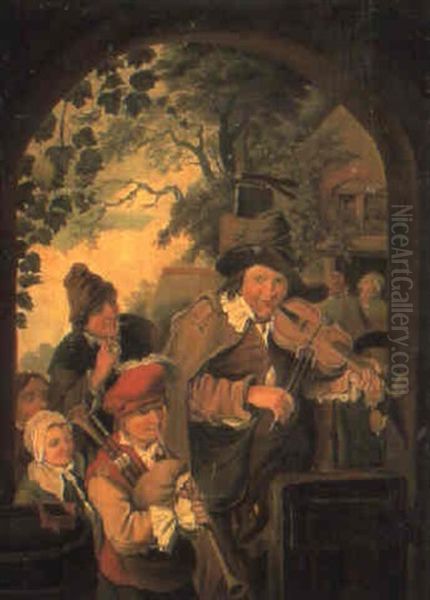
His stylistic range was vast. He frequently emulated the Dutch Golden Age masters. The influence of Rembrandt van Rijn is evident in Dietrich's handling of chiaroscuro (strong contrasts of light and shadow), particularly in his religious scenes and numerous etchings. He adopted the peasant genre scenes popularized by Adriaen van Ostade and Adriaen Brouwer, depicting lively, sometimes boisterous, tavern interiors and rural gatherings. The smooth finish and idyllic Italianate landscapes of painters like Cornelis van Poelenburgh also found echoes in some of Dietrich's smaller cabinet paintings.
Italian influences were equally prominent, especially following his trip south. The wild, romantic landscapes with craggy rocks, dramatic trees, and sometimes banditti, popularized by Salvator Rosa, became a recurring theme in Dietrich's work. He could also adopt the more classical, structured landscape style associated with artists like Claude Lorrain, though his inclination often leaned towards the more picturesque or dramatic. Mythological subjects, often treated in a Baroque or Rococo manner, also featured in his output.
French Rococo aesthetics, particularly the style of Jean-Antoine Watteau, also informed Dietrich's art. He painted fêtes galantes – elegant outdoor gatherings of aristocratic figures – and pastoral scenes imbued with a delicate, graceful charm reminiscent of Watteau and his followers like Nicolas Lancret or Jean-Baptiste Pater. This adaptability extended to Flemish masters as well; while not primarily a portraitist, the elegance in figure drawing sometimes recalls Anthony van Dyck, and the occasional dynamic composition might hint at an awareness of Peter Paul Rubens.
This stylistic flexibility was Dietrich's greatest strength and, paradoxically, the source of later criticism. He moved seamlessly between these different modes, often making it challenging to define a single, uniquely "Dietrich" style. Yet, the technical skill required to master so many distinct manners – capturing not just the look but the brushwork, color palette, and atmospheric quality of each – was undeniably impressive.
A Prolific Printmaker: Dietrich's Etchings
Beyond his paintings, Dietrich was one of the most significant German etchers of the 18th century. He produced a substantial body of work in this medium, with catalogues listing around 181 distinct plates. His etchings were highly sought after by collectors across Europe and played a crucial role in disseminating his artistic reputation. Like his paintings, his prints showcased his stylistic versatility.
His technical proficiency in etching was remarkable. He mastered various techniques to achieve rich tonal effects, intricate details, and expressive lines. The influence of Rembrandt, the undisputed master of etching, is particularly palpable in Dietrich's prints. He employed dramatic lighting, varied line work, and complex compositions, especially in his biblical scenes, such as the early and accomplished The Angel Preventing the Sacrifice of Isaac (1730).
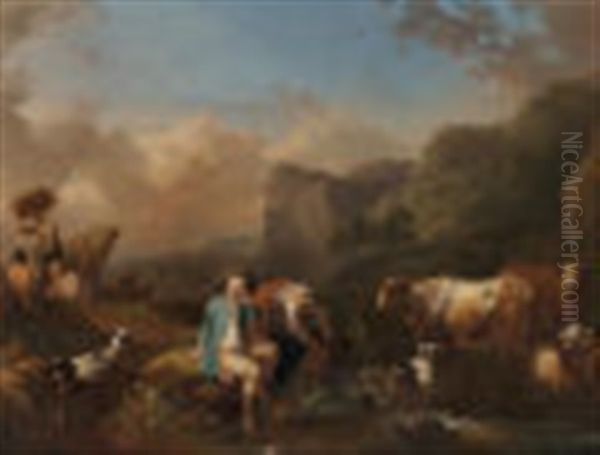
The subject matter of his etchings mirrored the diversity of his paintings. He created numerous landscapes, ranging from idyllic pastoral scenes to rugged, mountainous vistas like The River Between High Rocky Banks. Genre subjects were also popular, including depictions of peasants, travelers, and street vendors, exemplified by works like Pan Among the Peasants (1739) and the charming Peddler. Biblical narratives, such as The Return of the Prodigal Son (c. 1760s), allowed him to explore dramatic storytelling and complex figure arrangements in the manner of the Old Masters. These prints were admired for their technical finesse and their ability to capture the essence of the styles they emulated.
Signature Works and Artistic Range
While Dietrich is known more for his stylistic range than for iconic individual masterpieces, several works stand out and are frequently cited as representative of his talent. The Adoration of the Shepherds (c. 1760s), now in the Metropolitan Museum of Art, New York, exemplifies his ability to work in a Rembrandt-esque mode. The painting utilizes dramatic nocturnal lighting, focusing a warm glow on the central figures of the Holy Family, while the surrounding shepherds emerge from deep shadow, creating a sense of intimacy and reverence.
The Itinerant Musicians (1745), housed in the National Gallery, London, showcases his skill in Dutch-style genre painting. The detailed rendering of the figures, their expressive gestures, the textures of their clothing, and the carefully depicted setting recall the work of artists like Adriaen van Ostade. It captures a lively moment of everyday life with keen observation and technical polish.
His oeuvre encompassed a wide array of themes beyond these examples. Mythological paintings often depicted scenes with gods and goddesses, nymphs and satyrs, sometimes set in lush landscapes. His landscapes varied greatly, from the meticulously detailed Dutch-inspired views to the broader, more atmospheric Italianate scenes influenced by Rosa or Claude. While portraits were not his primary focus, he did execute some, often characterized by the prevailing Rococo elegance. This breadth demonstrates his ambition to master nearly every genre and style esteemed in his era.
Dietrich's Role in Dresden's Art World
Dietrich was not just a prolific artist; he was also an influential figure within the institutional art structure of Dresden. In 1746, he was appointed Inspector of the prestigious Gemäldegalerie, the Elector's art collection housed in the Stallhof. This position gave him intimate access to one of Europe's finest collections of Old Masters, further fueling his study and imitation of various styles. It also placed him in a position of authority and influence within the Dresden art scene.
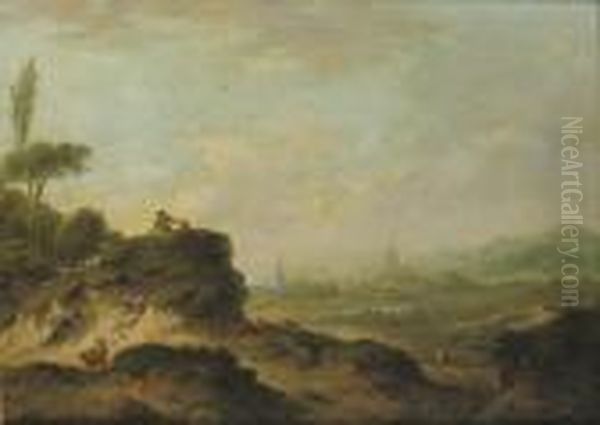
Furthermore, Dietrich played a significant role in art education. In 1764, he became a professor at the newly reorganized Dresden Academy of Fine Arts (Hochschule für Bildende Künste Dresden). He also directed the associated school of painting. In this capacity, he trained a generation of artists, passing on his technical knowledge and broad understanding of art history. Notable pupils included Johann Christian Klengel, who became a respected landscape painter and etcher in his own right, and Johann Eleazar Zeissig, known as Schenau, who achieved success as a genre and portrait painter, eventually becoming a director of the Academy himself.
His standing in Dresden was considerable. He operated within a vibrant artistic milieu that included other major talents. The Venetian view painter Bernardo Bellotto, nephew of Canaletto, was active in Dresden for much of Dietrich's prime, documenting the city's architecture with meticulous detail. Although representing a different artistic direction, the leading Neoclassical painter Anton Raphael Mengs also had strong ties to Dresden, serving as court painter before finding greater fame in Rome. Visiting artists, such as the Swiss pastellist Jean-Étienne Liotard, further enriched the city's cultural life during Dietrich's tenure.
Navigating the Art World: Contemporaries and Context
Dietrich's career unfolded during a period of transition in European art. The late Baroque and Rococo styles were dominant during his formative years, but the stirrings of Neoclassicism and, later, Romanticism were beginning to emerge. His work reflects this complex interplay of styles. While he mastered the Rococo grace of Watteau, his output often retained a connection to the more robust traditions of the Dutch and Italian Baroque.
Placing him among his contemporaries highlights his unique position. In France, artists like François Boucher and Jean-Honoré Fragonard pushed the Rococo style to its zenith, while Jean-Baptiste-Siméon Chardin offered quiet, intimate genre scenes. In landscape, Claude-Joseph Vernet was gaining fame for his dramatic seascapes and topographical views. In England, Thomas Gainsborough was developing his distinctive portrait and landscape style. Compared to these figures, who largely developed more singular artistic identities, Dietrich's strength lay in his synthesis and adaptation.
Within Germany, other notable artists were active. Daniel Chodowiecki in Berlin was a prolific etcher and illustrator, known for his depictions of bourgeois life. Anton Graff, working primarily in Dresden later in Dietrich's life and after his death, became one of the leading portrait painters in the German-speaking world. Dietrich's focus on stylistic versatility set him apart from these contemporaries, who generally pursued more consistent personal styles. His work can be seen as a culmination of the 18th-century appreciation for art historical knowledge and technical mimicry, existing just before the Romantic emphasis on individual genius and originality took hold.
Fame, Criticism, and Enduring Legacy
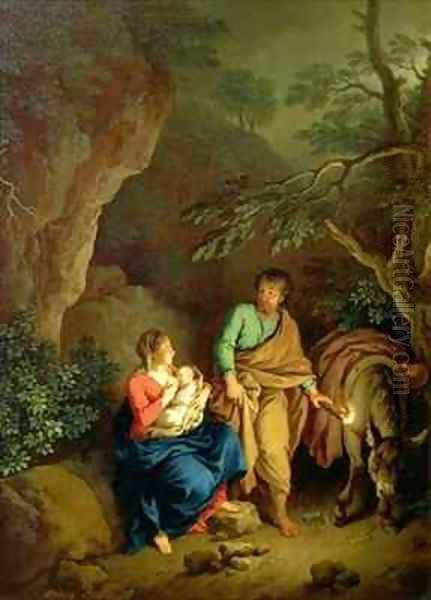
During his lifetime, Christian Wilhelm Ernst Dietrich enjoyed considerable fame and success. His paintings and etchings were highly sought after by royalty, aristocracy, and bourgeois collectors across Europe. His ability to provide works "in the style of" famous masters made his art desirable for decorating interiors and complementing existing collections. Royal patronage from the Saxon Electors ensured a steady stream of commissions and prestigious appointments.
However, the very quality that brought him fame – his eclecticism – became a point of criticism, particularly from the late 18th century onwards. With the rise of Neoclassicism, spearheaded by theorists like Johann Joachim Winckelmann (who also had Dresden connections), and the subsequent Romantic movement, artistic value shifted towards originality, individual expression, and moral seriousness. Dietrich's stylistic mimicry began to be viewed as lacking invention, a mere pastiche rather than genuine creation. Consequently, his reputation declined significantly during the 19th century, and he was often relegated to the status of a minor, albeit technically skilled, imitator.
In the 20th and 21st centuries, there has been a more nuanced reassessment of Dietrich's work. Art historians now recognize his exceptional technical abilities, both as a painter and, especially, as an etcher. His deep understanding of art history and his skill in synthesizing diverse influences are appreciated in their own right. His work is seen as representative of a specific moment in 18th-century taste and collecting practices. While the criticism regarding originality persists to some extent, his importance within the context of German art of his period, particularly in Dresden's golden age, is undisputed.
His works continue to appear on the art market, though attribution can sometimes be complex due to contemporary copies and workshop versions. His paintings are found in major museums worldwide, and his etchings remain highly regarded by print collectors. The renewed interest acknowledges him not just as an imitator, but as a master craftsman and a significant conduit through which the styles of the past were understood and appreciated in the 18th century.
Conclusion
Christian Wilhelm Ernst Dietrich, or Dietricy, remains a compelling figure whose career encapsulates the artistic tastes and transitions of the 18th century. A master technician in both painting and etching, he navigated the demands of court patronage and the broader art market with remarkable success. His defining characteristic, an unparalleled ability to work in the diverse styles of Dutch, Italian, and French masters – from Rembrandt to Watteau, from Rosa to Ostade – brought him contemporary fame but also led to later criticism regarding originality.
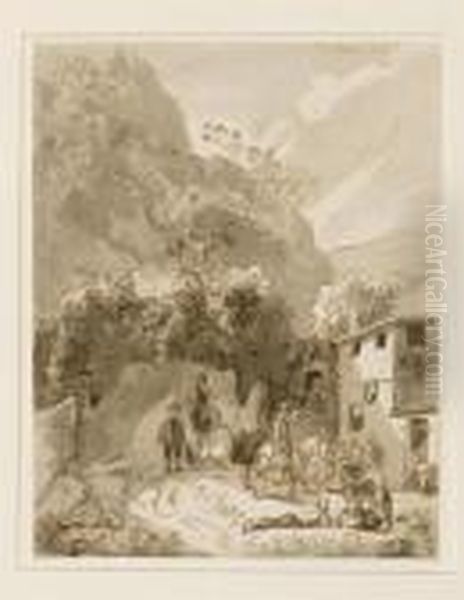
As a court painter, Inspector of the Dresden Gemäldegalerie, and Professor at the Academy, he was a central figure in one of Europe's most vibrant artistic centers. His prolific output, particularly his influential etchings, and his role as a teacher ensured his impact on German art. While perhaps not an innovator in the modern sense, Dietrich was a consummate professional, a repository of artistic knowledge, and a skillful synthesizer whose work provides invaluable insight into the complex artistic landscape of his time. His legacy is that of a master of styles, a technical virtuoso whose art reflects both the brilliance and the specific aesthetic values of the European Rococo and early Enlightenment era.